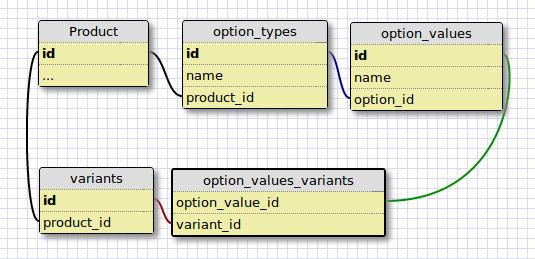Advanced Product Options (Variants) in Piggybak
About a month ago, Tim Case and I developed and released a Piggybak extension piggybak_variants, which provides advanced product optioning (or variant) support in Piggybak. Piggybak is an open source Ruby on Rails ecommerce platform developed and maintained by End Point. Here, I discuss the background and basics of the extension.
Motivation & Background
The motivation for this extension was the common ecommerce need for product options (e.g. size, color), where each variation shares high-level product information such as a title and description, but variants have different options, quantities available, and prices. Having been intimately familiar with Spree, another open source Ruby on Rails ecommerce framework, we decided to borrow similarities of Spree’s product optioning data model after seeing its success in flexibility over many projects. The resulting model is similar to Spree’s data model, but a bit different due to the varied nature in Piggybak’s mountability design.

Spree’s data model for advanced product optioning. A product has many variants. Each variant has and belongs to many option values. A product also has many options, which define …
ecommerce piggybak rails
Lazy AJAX
Don’t do this, at least not without a good reason. It’s not the way to design AJAX interfaces from scratch, but it serves well in a pinch, where you have an existing CGI-based page and you don’t want to spend a lot of time rewriting it.
I was in a hurry, and the page involved was a seldom-used administration page. I was attempting to convert it into an AJAX-enabled setup, wherein the page would stand still, but various parts of it could be updated with form controls, each of which would fire off an AJAX request, and use the data returned to update the page.
However, one part of it just wasn’t amenable to this approach, or at least not quick-and-dirty. This part had a relatively large amount of inline interpolated (Interchange) data (if you don’t know what Interchange is, you can substitute “PHP” in that last sentence and you’ll be close enough.) I wanted to run the page back through the server-side processing, but only cared about (and would discard all but) one element of the page.
My lazy-programmer’s approach was to submit the page itself as an AJAX request:
$.ajax({
url: '/@_MV_PAGE_@',
data: { …interchange javascript jquery
tmux and SecureCRT settings
Richard gave me a call today to show the wonders of tmux. I am using Windows, and unfortunately, right off the bat I couldn’t see color and there were a bunch of accented as dividing the panes.
After some trial and error and finding this post on the subject we got it working. The key is to configure SecureCRT to use xterm + ANSI colors and set the character set to UTF-8 and “Use Unicode line drawing code points”.
Hooray! I’ll be trying out tmux in day-to-day use to see if it will replace or augment screen for me.
terminal
Update Your GNU Screen Config on the Fly
An Indispensable Tool
I use Screen constantly in my work at End Point. It is an indispensable tool that I would not want to operate without. It’s so handy to resume where I left off after I’ve detached or when my connection drops unexpectedly. This is likely preaching to the choir but if you are not already using Screen and/or tmux, start now.
The Scenario
I often find myself in the following situation:
- SSH into a server
- Fire up a new Screen session
- Create several windows for editing files, tailing logs, etc.
- Realize the default Screen configuration is inadequate or does not exist.
- Facepalm \O/
While my needs are fairly minimal, I do like to bump up the scrollback buffer and display the list of windows in the status line.

There are a couple of options at this point. I could put up with the default / non-existent configuration or create a config file and manually re-create the session and all of the windows to pick up the configuration changes. Neither of these options was desirable.
I wanted to be able to update the configuration and have all of the existing windows pick up the changes. After asking around a little I ended up taking a look at the manual and discovered the …
terminal tips
Is AVS for International Customers Useless?
Any ecommerce site that sells “soft goods”, some digitally delivered product, has to deal with a high risk of credit card fraud, since their product is usually received instantly and relatively easily resold. Most payment processors can make use of AVS (Address Verification System). It usually works well for cards issued by United States banks with customers having a U.S. billing address, but its track record with international customers and banks has been less than stellar.
AVS compares a buyer’s address information with what the bank has on file for the card’s billing address. To reduce false negatives, that comparison is limited to the postal code and the numeric part of the street address. The lack of consistent AVS implementation by non-U.S. banks, and the variety of postal codes seen outside the U.S., Canada, and the U.K., mean problems creep in for most international orders.
Any time you reject an order, whether it’s for a legitimately incorrect billing address, a bank/AVS problem, or any other reason, you’re increasing the likelihood of losing the customer’s business, having them retry and cost you more in payment processing fees, …
ecommerce payments
Piggybak Extensions: A Basic How-To Guide
This article outlines the steps to build an extension for Piggybak. Piggybak is an open-source Ruby on Rails ecommerce platform created and maintained by End Point. It is developed as a Rails Engine and is intended to be mounted on an existing Rails application. If you are interested in developing an extension for Piggybak, this article will help you identify the steps you need to take to have your extension leveraging the Piggybak gem, and integrating smoothly into your app.
Introduction
The Piggybak platform is lightweight and relies on Rails meta-programming practices to integrate new extensions. The best references to use alongside your development should be the previously developed extensions found here:
It is likely that your extension will tie into the admin interface. Piggybak utilizes the RailsAdmin gem for its admin interface.
Setting up the Development Environment
A convenient way to start building out your extension is to develop against the demo app found here. The demo app utilizes the Piggybak gem and comes with sample data to populate the e-commerce store.
The Piggybak demo app sample data is exported …
piggybak rails
Custom validation with authlogic: Password can't be repeated.
I recently worked on a small security system enhancement for one of my projects: the user must not be able to repeat his or her password for at least ten cycles of change. Here is a little recipe for all the authlogic users out there.
We will store ten latest passwords in the users table.
def self.up
change_table :users do |t|
t.text :old_passwords
end
endThe database value will be serialized and deserialized into Ruby array.
class User
serialize :old_passwords, Array
endIf the crypted password field has changed, the current crypted password and its salt are added to the head of the array. The array is then sliced to hold only ten passwords.
def update_old_passwords
if self.errors.empty? and send("#{crypted_password_field}_changed?")
self.old_passwords ||= []
self.old_passwords.unshift({:password => send("#{crypted_password_field}"), :salt => send("#{password_salt_field}") })
self.old_passwords = self.old_passwords[0, 10]
end
endThe method will be triggered after validation before save.
class User
after_validation :update_old_passwords
endNext, we need to determine if the password has changed, excluding …
rails
Interactive Piggybak Demo Tour
A new interactive tour of Piggybak and the Piggybak demo has been released at piggybak.org. Piggybak is an open source Ruby on Rails ecommerce framework built as a Rails 3 engine and intended to be mounted on existing Rails applications.
The tour leverages jTour (a jQuery plugin) and guides you through the homepage, navigation page, product page, cart and checkout pages, gift certificate page, advanced product option page, and WYSIWYG driven page. The tour also highlights several of the Piggybak plugins available and installed into the demo such as plugins that introduce advanced product navigation, advanced product optioning, and gift certificate functionality. Below are a few screenshots from the demo.
An interesting side note of developing this tour is that while I found many nice jQuery-driven tour plugins available for free or at a small cost, this jQuery plugin was the only plugin offering decent multi-page tour functionality.
javascript jquery piggybak rails









